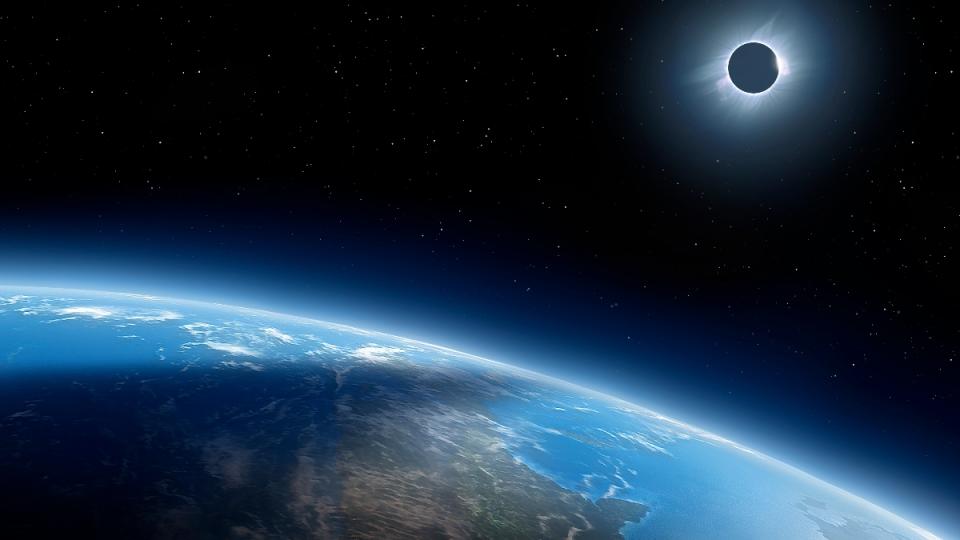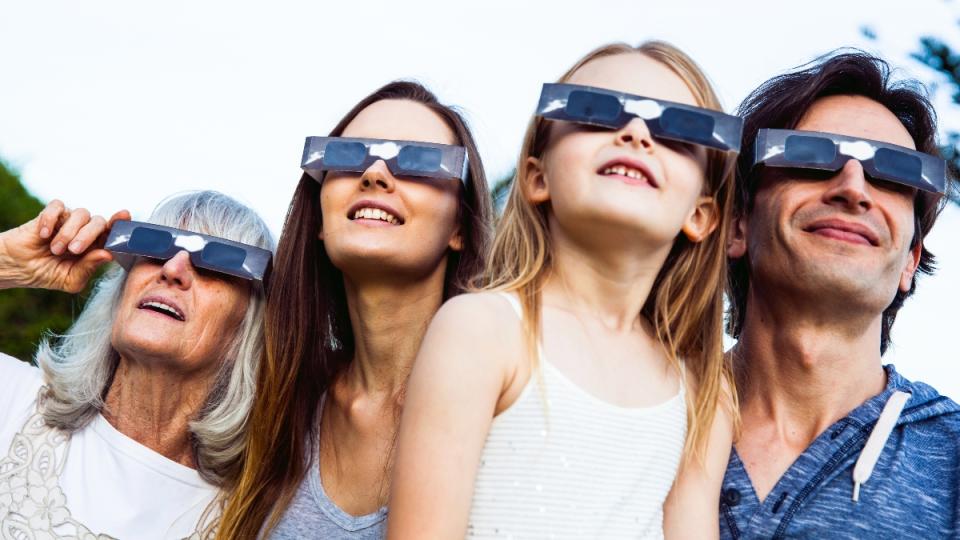The 2024 Total Eclipse: How to Watch and What to Expect
On April 8, 2024, many Americans will get to experience a spectacular scientific event: a total solar eclipse! This phenomenon has the country buzzing with excitement as people make their plans for catching a glimpse. But you may be wondering what to expect when the eclipse finally occurs. Below, you’ll find information about the April 8 eclipse, including what happens in the path of totality, how to stay safe watching and how to enjoy the eclipse regardless of where you’re located.
What is an eclipse?

“A solar eclipse happens when a new moon moves between the Earth and the sun, blocking some of all of the sun’s rays from reaching the Earth,” explain the pros at National Geographic in this video. “By cosmic chance, even though the sun is 400 times wider than the moon, it’s also 400 times farther away. Therefore, the two objects appear the same size in our sky.”
There are four types of eclipses that can occur: a hybrid eclipse, annular eclipse, a partial eclipse and total eclipse. While all are impressive, this one is especially thrilling because not everyone gets to experience it!
“A total eclipse can only be seen if you’re standing within the umbral shadow,” the National Geographic experts explain. “That’s why the imaginary line created by this shadow as it races across Earth is known as the path of totality.”
Learn more about eclipses in their video below:
The experience in the path of totality
Total eclipses occur around every 18 months, but not in the same locations. And on April 8, 2024, a large portion of the United States will have a chance to see it. More than 30 million Americans will be in the path of totality.
Though the eclipse only lasts for around three minutes, many towns and cities are holding special celebrations in its honor. A nonprofit organization called the Simons Foundation (whose mission is to advance science) has created an initiative called In the Path of Totality to provide support to museums, art and cultural centers and Main Streets in these locations.
“For a few minutes on this spring afternoon, people living in these communities will have some of the best views in the solar system — and that warrants coming together to celebrate,” says Anastasia Greenebaum of the Simons Foundation. “The foundation is spotlighting towns — from Texas to Maine — that fall in this narrow path because we believe that everyone should have an opportunity to engage with science in a place they call home.”
To see if you are in the path of totality, click here. You can also find fun events and gatherings being hosted along the path!
Even without attending a special event, you still may notice some impressive natural wonders if you're in the path. “In totality, insects and animals that are commonly vocal at night may come alive during the eclipse,” adds Greenebaum. “Night birds may come out. Flowers may close up or bloom! Nocturnal animals are often tricked by the sudden darkness. Crickets, frogs, and toads might sing their nightly songs.”
How to safely watch an eclipse

Watching the eclipse can be a memorable experience, but you’ll want to do so safely. Staring at the the sun can damage your eyes at any time because of the brightness. Note: The actual moment of totality is completely safe for your eyes, as the moon will fully block the sun. But the rest of the time, eye protection is crucial.
(The rest of your body will certainly appreciate the sun, however! Read why Vitamin D is so crucial for good health!)
To ensure you protect your eyes during the experience, pick up a pair of eclipse glasses, which help block out harmful ultra-violet rays, infrared and intense visible light. You can buy them at websites like EclipseGlasses.com.
If you’re planning on looking through a telescope, camera lens or binoculars, you will still need a solar filter to guarantee safe viewing.
Related: Treating *This* Common Cause of Blurriness Can Improve Your Vision in 7 Days
Other ways to watch the total eclipse
If you’re not in the path of totality, you can still participate in the fun! The entire country will witness a partial eclipse, which means you can see the moon and sun crossing paths.
What time to watch? According to the folks at NASA, Mexico will experience the total eclipse at 11:07 am PDT. The path continues through several states, exiting North America via Newfoundland, Canada, at 5:16pm NDT.
You can watch the total solar eclipse occurring in real-time right from the comfort of your house. NASA will have a live broadcast and share views from across the path, plus provide expert commentary and other information. Simply tune in between 1 and 4 p.m. EDT for a shared experience.
Test your eyes after the eclipse
Despite eye doctors' warnings not to look directly at the sun, many people worry about their eyes after the fact. Here’s an at-home test you can take that will help you determine if you've experienced any post-eclipse damage.
To do: Download the Amsler Grid, a test you can use to monitor vision changes. Doctors often recommend it for people with macular degeneration.
Related: Opthalmologist: These Nutrients Can Protect Your Sight From Macular Degeneration
Find a room with normal lighting and hold the piece of paper about 14 to 16 inches away from your face. If you typically wear reading glasses, you should take the test while wearing those glasses. Now, cover one eye with your other hand, focus on the black dot in the center of the grid, and answer these questions:
— Do any of the lines look wavy or distorted?
— Do all the boxes look like same-sized squares?
— Are there any “holes” (missing areas) or dark areas on the grid?
— Can you see all sides and ends of the grid while still focusing on the black dot?
After checking both eyes, if you notice that you saw wavy or distorted lines or dark or missing areas of the grid, you should get your eyes checked. You should also visit an eye doctor if you had trouble seeing all the sides and corners of the grid while staring at the center dot.
Solve the daily Crossword

